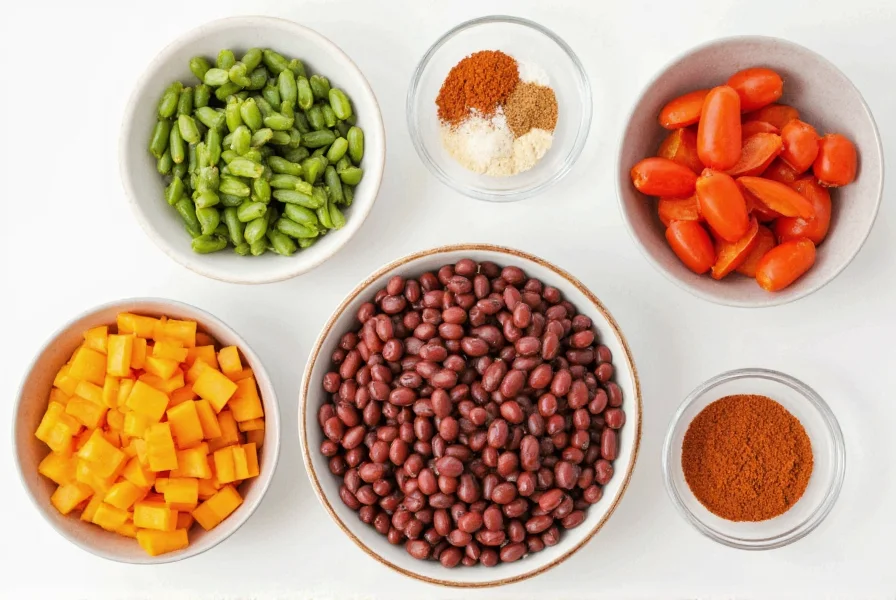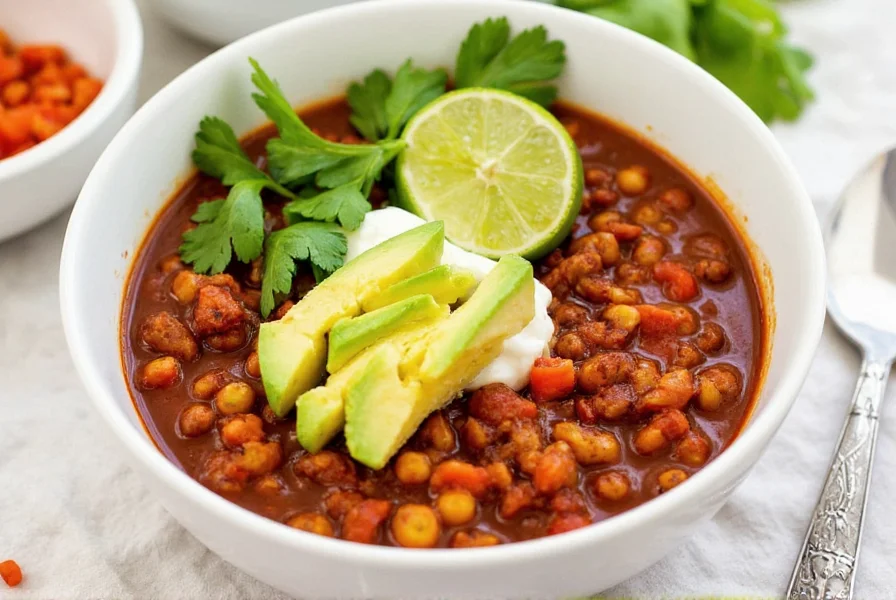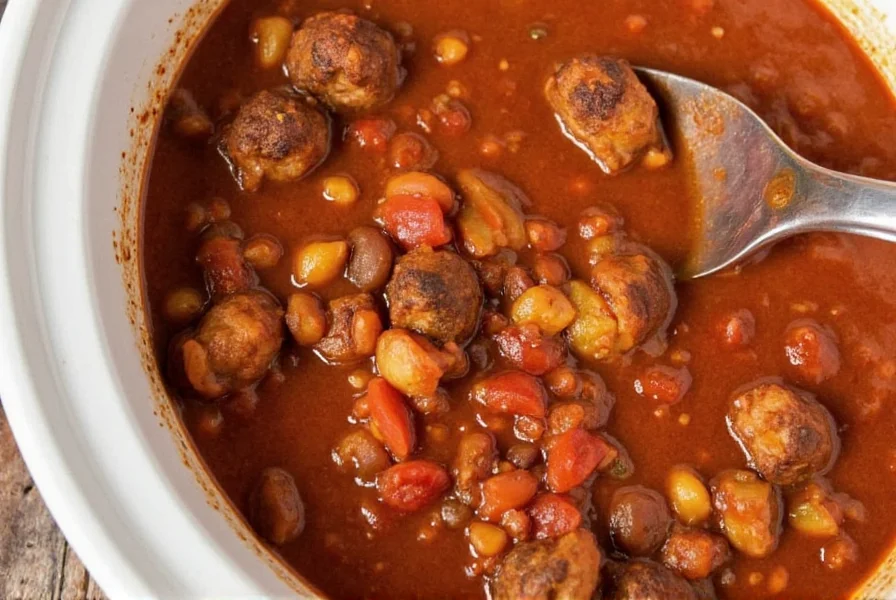A well-crafted vegetarian slow cooker chili delivers robust flavor without meat through strategic layering of ingredients and proper spice balancing. Unlike stovetop versions, the slow cooker's gentle heat allows flavors to meld while maintaining distinct vegetable textures. The magic happens through a combination of time, temperature control, and ingredient selection that transforms simple pantry staples into a nutritionally complete meal.
Essential Ingredients for Flavorful Meatless Chili
Creating exceptional vegetarian slow cooker chili starts with understanding which ingredients provide umami depth and protein richness traditionally found in meat-based versions. The foundation consists of three critical components:
| Ingredient Category | Key Options | Flavor Contribution |
|---|---|---|
| Bean Varieties | Kidney, black, pinto, cannellini | Protein base with different textures and earthy notes |
| Umami Builders | Mushrooms, tomato paste, soy sauce, smoked paprika | Creates meaty depth without animal products |
| Vegetable Foundation | Onions, bell peppers, carrots, zucchini | Sweetness and texture complexity |
Professional chefs recommend using at least three bean varieties for textural interest. Canned beans work perfectly when rinsed thoroughly, though soaked dried beans yield superior texture. For maximum flavor development, sauté onions, garlic, and spices before adding to the slow cooker—a step many beginners skip that makes a significant difference in final taste.
Step-by-Step Preparation Guide
Follow this tested method for consistently excellent vegetarian slow cooker chili:
- Prep vegetables: Dice onions, bell peppers, and carrots into uniform 1/4-inch pieces for even cooking
- Bloom spices: Cook chili powder, cumin, and smoked paprika in oil for 1 minute to release essential oils
- Layer ingredients: Place harder vegetables at bottom, beans in middle, tomatoes on top
- Liquid ratio: Use 1.5 cups broth per 4 cups solid ingredients for ideal consistency
- Cooking time: 6-8 hours on low (never high) for optimal flavor development
- Final adjustment: Stir in lime juice and fresh cilantro during last 30 minutes

Proven Techniques for Better Results
Achieve restaurant-quality vegetarian slow cooker chili with these professional techniques:
- Acid balance: Add 1-2 tablespoons of apple cider vinegar during last hour to brighten flavors
- Texture control: Mash 1/4 of beans before cooking for natural thickening
- Spice timing: Add delicate herbs like oregano during final 2 hours to preserve flavor
- Temperature management: Never lift the lid during first 4 hours to maintain consistent heat
Many home cooks make the mistake of overfilling their slow cooker. For best results, fill only 1/2 to 2/3 full to allow proper heat circulation. If your chili turns out too thin, create a slurry with 2 tablespoons cornstarch and 1/4 cup cold water, stirring in during the last 30 minutes of cooking.
Customization Options for Dietary Needs
Vegetarian slow cooker chili adapts beautifully to various dietary preferences:
- Vegan version: Ensure broth is vegetable-based and omit any dairy toppings
- Gluten-free: Naturally compliant when using certified gluten-free broth
- Lower sodium: Use no-salt-added beans and make your own spice blend
- Higher protein: Add 1 cup cooked quinoa or textured vegetable protein during last hour

Serving and Storage Recommendations
Maximize your vegetarian slow cooker chili experience with these serving suggestions:
- Rest for 20 minutes after cooking for flavors to fully integrate
- Top with cooling elements like avocado or Greek yogurt to balance spices
- Pair with cornbread or whole grain rice for complete meal
- Freeze in portion-sized containers for up to 3 months
- Reheat gently on stove with splash of water to restore texture
Meal preppers appreciate that vegetarian slow cooker chili actually improves in flavor after 24-48 hours as ingredients continue to meld. The dish provides approximately 15 grams of plant-based protein per serving while delivering substantial fiber content from the diverse bean varieties.
Frequently Asked Questions
Can I make vegetarian slow cooker chili without tomatoes?
Yes, you can substitute tomatoes with roasted red peppers or butternut squash puree for similar acidity and body. Add 1 tablespoon balsamic vinegar to compensate for missing tomato acidity while maintaining balanced flavor.
How do I prevent beans from becoming mushy in slow cooker chili?
Add canned beans during the last 2 hours of cooking. For dried beans, soak overnight and pre-cook separately until just tender before adding to the slow cooker. This prevents overcooking while maintaining distinct texture in your vegetarian slow cooker chili.
What's the best way to thicken vegetarian slow cooker chili?
Create a natural thickener by mashing 1/2 cup of the cooked beans with a fork and stirring back into the chili. Alternatively, mix 2 tablespoons cornstarch with 1/4 cup cold water and stir in during the last 30 minutes of cooking for perfect vegetarian slow cooker chili consistency.
Can I use frozen vegetables in vegetarian slow cooker chili?
Yes, frozen corn, peppers, and onions work well in vegetarian slow cooker chili recipes. Add them directly without thawing, but increase cooking time by 30-60 minutes. Avoid frozen tomatoes as they become watery when cooked.











 浙公网安备
33010002000092号
浙公网安备
33010002000092号 浙B2-20120091-4
浙B2-20120091-4